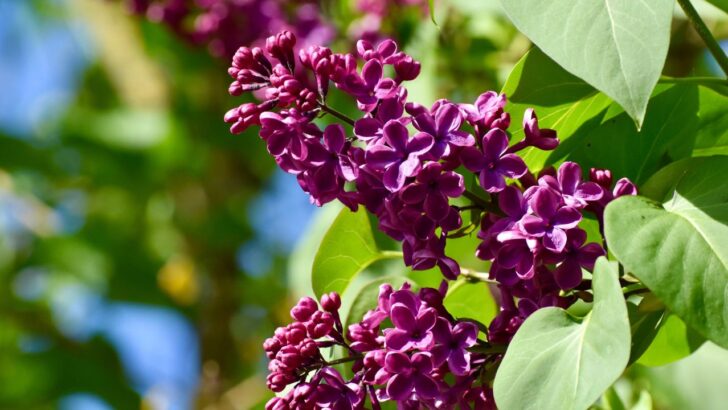Whether it is the redbuds around Lake Michigan in late April, the saucer magnolias in Northern California in late April, or the American dogwoods that grace the South in early spring, chances are that there are some spring flowering trees that will do well near you.
If you want your landscape trees to announce the arrival of spring with your favorite flowering trees, you need to do a little homework. You need to be sure that you have a suitable site for your favorite spring flowering tree, as well as the soil and climate that can support it. You will need to be sure that there aren’t any local pests or quirky climate conditions that can spoil their bloom.
Let’s look at the seven most popular spring flowering trees, and how to adapt your garden for them. With a little work, most people can grow at least one species of spring-flowering tree that will become the talk of the neighborhood every year.
1. Flowering cherry (Prunus serrulata)
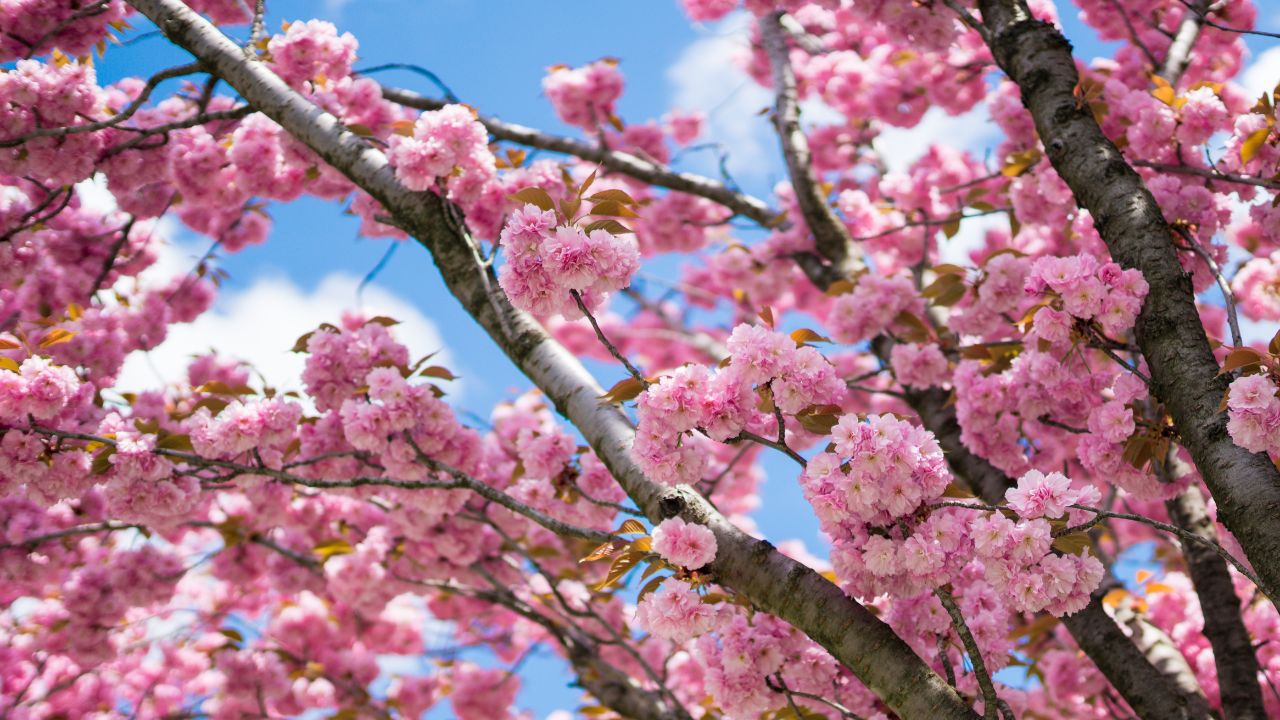
Image Credit: Shutterstock.
Flowering cherry trees, more specifically Japanese flowering cherry trees, are the product of over 1,000 years of horticultural refinements. Some of the individual trees used for hybridizing modern Japanese flowering cherry trees are still alive, up to 2,000 years old.
In the 1500s and 1600s, Japanese horticulturalists crossed cherry tree varieties to create “double flowers” that have up to 50 petals. About 125 years ago, all varieties of cherry trees except Yoshinos were cut down, but an English gardener named Collingwood Ingram smuggled a number of the varieties we enjoy today out of the country.
So what can you grow where in the U.S.?
- Flowering cherry trees grafted onto sour cherry rootstock are only viable in USDA Hardiness Zones 4 through 6.
- Container-grown flowering cherry trees will put on a show in climates as warm as USDA Hardiness Zone 9. All flowering trees tolerate hot, humid summers, but are sensitive to drought. Different varieties have different needs for chilling hours for spring bloom.
2. Saucer magnolias (Magnolia X soulangeana)
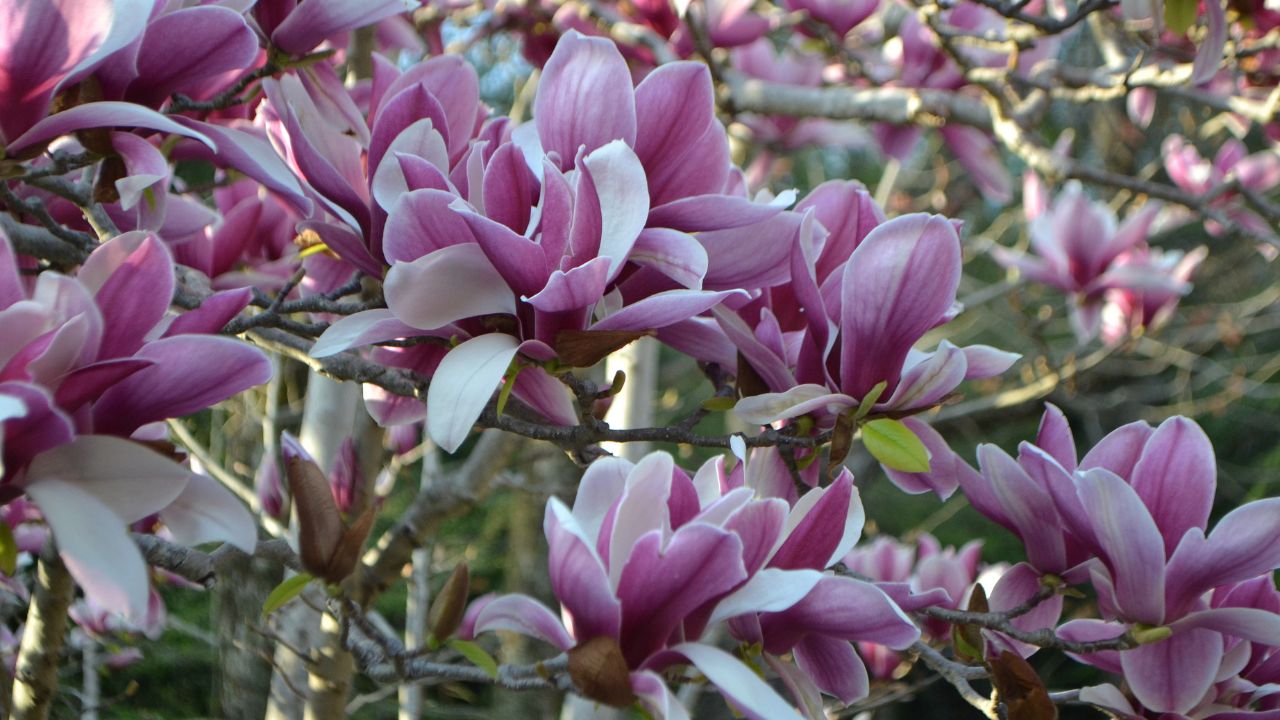
Image Credit: Shutterstock.
There are over eight species of magnolias that are native trees in the United States. Two of them are evergreen, and six drop their leaves every fall. North American magnolias are extremely adaptable, growing in gardens in climates and soils where they are never found in nature.
Magnolias can have flowers that are star-shaped, bowl-shaped, or saucer-shaped. The saucer-shaped or “saucer magnolias” (Magnolia x soulangeana) are the most popular magnolia for planting in the United States. They are a deciduous variety that looks good even during the winter when it has no leaves. They come in different strains that allow you to choose the kind of flower that you like.
Young saucer magnolias can be grown in containers for three or four years. Be sure you plant saucer magnolias in full sun or afternoon partial shade, and water them regularly during the growing season.
Saucer magnolias are suitable for USDA Hardiness Zones 5 through 9. Most of them will grow to between 15 and 30 feet tall, although 70-foot specimens are not unknown.
If you live in a location that has long summer droughts and cool late summer nights, your saucer magnolia may bloom twice a year, in the fall as well as in the spring. Unusually dry summers in normally moist climates may also result in autumn flowering.
3. Redbud (Cercis canadensis)
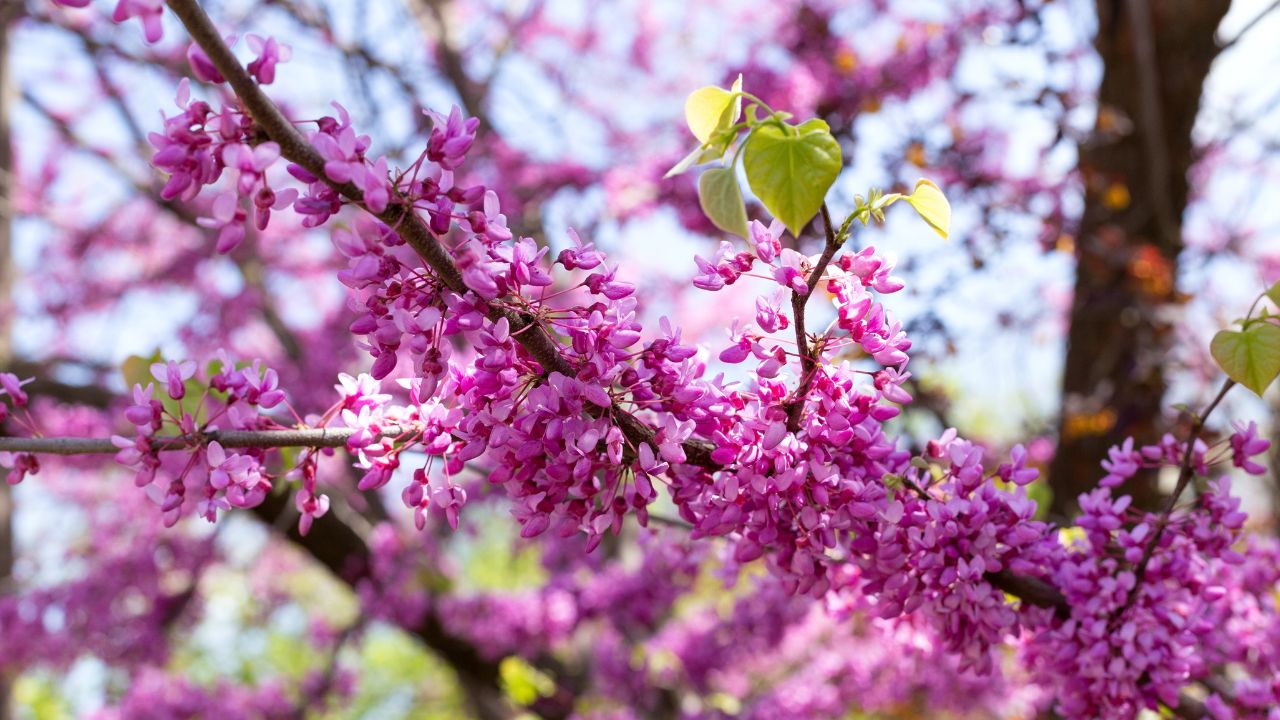
Image Credit: Shutterstock.
Cercis canadensis, the Eastern redbud, a member of the Legume Family, explodes into purple blooms (or white) blooms in early spring. Redbuds put on purple blooms, followed by purple seed pods that are a favorite food of birds and squirrels. The Forest Pansy variety bears attractive red-orange leaves in the fall. This tree is available in a variety of forms that fit into every landscape, although it is best used as an understory plant.
Eastern redbuds grow taller, have fewer diseases, and put on more flowers than their Western counterparts. They survive winters in USDA Hardiness Zones 4 through 9, but they will need supplemental watering in the summer if grown in full sun or in rocky or sandy soils. Native Eastern redbuds grow 30 feet tall, but you can find varieties that are small trees that thrive in partial sun.
No matter what variety of redbud you plant, it will be happier as an understory tree. It uses most of its annual energy by generating blossoms in the spring, so the trees growing over it should be deciduous, preferably slow to leaf out. That way, your redbud has lots of sunshine in the spring when it needs it most, but gains protection from the summer sun.
4. Flowering crabapple (Malus)

Image Credit; Shutterstock.
No temperate-zone flowering tree puts on a more spectacular display of spring blooms than the flowering crabapple, but almost no other flowering tree loses its flowers as quickly. However, you can take advantage of the fact that flowering crabapples sometimes “lose track of time,” blooming in the fall as well as in the spring.
Flowering crabapples grow in USDA Hardiness Zones 3 through 9, but it is important to choose a variety suited for your winter conditions. That’s because crabapples have a chilling requirement. Once plants have been exposed to the right number of hours of temperatures between 32° F and 50° F, they will bloom, whether the calendar says it is spring or not. On the other hand, if flowering crabapples don’t get enough chilling hours between fall and the next spring, they will bloom very poorly or not bloom at all.
All flowering crabapples require well-drained soil with constant but not excessive moisture. Crabapples normally grow about 25 feet tall, but grafts to dwarfing rootstock will top out at about 8 feet tall.
5. Flowering dogwood (Cornus florida)

Image Credit: Shutterstock.
Flowering dogwoods in the genus Cornus are a group of about 60 trees that occur around the world in a variety of growing conditions. There are dogwoods grown as ornamental trees, like the Cornus florida in North America, but there are also dogwoods grown for their berries that go into Chinese and Korean candies and carbonated beverages, and the lily magnolia used in floral displays.
Most of the flowering dogwoods are deciduous. They burst into white and pink blooms in the spring, bear luxurious green foliage all summer that matures to a glorious red in the fall, and then display red berries and bare branches with distinctive bark through the winter.
Some dogwoods, however, are evergreen. There are dogwoods that reach a height of 80 feet in forests in the southern United States, and there are dogwoods that spend their lives as scrubby bushes that scarcely reach 2 feet.
Dogwoods can be grown in USDA Hardiness Zones 5 through 9, but they are particular about moisture. Dogwoods cannot withstand drought or flood.
Two varieties of dogwood, Cornus kousa and Cornus mas, are sold as edible fruit trees. The fruit of the Cornus kousa has hard pits surrounded by flesh that is often described as “tropical fruit pudding.” Cornus mas fruits are tart and sweet. Rich in vitamin C, both of these dogwood fruits are used as remedies for colds and flu.
More than the other flowering trees on this list, dogwoods benefit from regular pruning to make sure air flows between their branches. Dogwoods grown in locations with long stretches of cool, wet spring weather are prone to a fungal disease called anthracnose. This condition causes yellow blotching of the leaves and death of the twigs that support them. If it reaches the main trunk, it will kill the tree.
6. Purple-leaf plum (Prunus cerasifera)
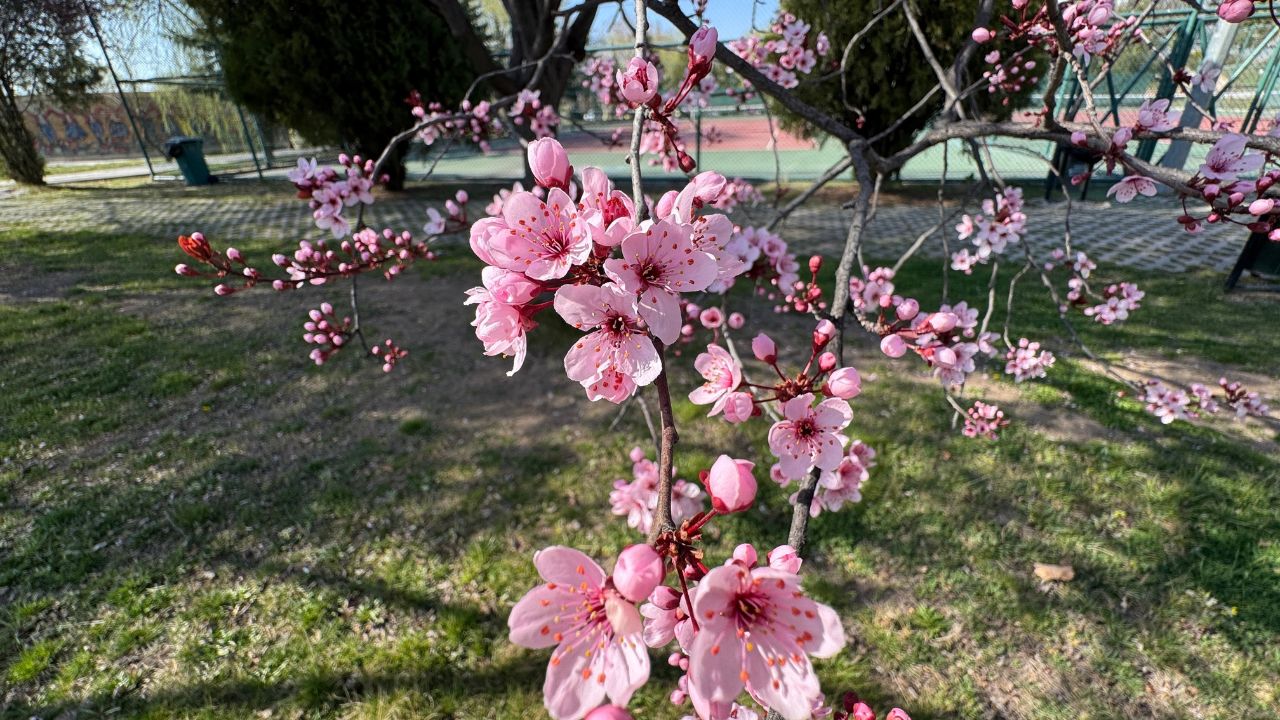
Image Credit: Shutterstock.
Purple-leaf plums aren’t as showy during their blooming season as the other trees on this list, but they display colorful purple foliage beginning in late spring that lasts until late fall. Leaves briefly turn bright red about the same time as the first hard frost.
Purple-leaf plums like to be the center of attention. They grow up to 25 feet tall and need full sun to thrive. These trees get very few diseases, and they survive the summer heat and drought with ease. If you get a fruiting variety, however, it may make a mess you need to clean up as the tiny fruits fall.
7. Common lilac (Syringa vulgaris)

Image Credit: Shutterstock.
A popular flowering tree with a distinct and delightful fragrance, lilac trees are renowned for their showy blooms and grace gardens and landscapes everywhere.
Lilacs bloom between April and June depending on the zone and produce an abundance of fragrant flowers in shades of purple, pink, white, and blue. The flowers are short-lived, typically lasting for only a few weeks, but they make a dramatic impact while they last.
Lilacs are hardy and will grow in a variety of soil types, but they prefer well-drained soil with a slightly acidic pH and full sun.
Lilac trees are generally easy to care for and can tolerate some drought, but they may require occasional watering during hot, dry weather.

